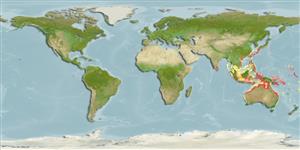>
Carangaria/misc (Various families in series Carangaria) >
Leptobramidae (Beachsalmon)
Etymology: Leptobrama: Greek, leptos = thin + old French breme, bresme, a fresh water fish; 1460 (Ref. 45335).
More on author: Steindachner.
Environment: milieu / climate zone / depth range / distribution range
Ökologie
seewasser; süßwasser; brackwasser pelagisch. Tropical
Indo-West Pacific: northern Australia.
Size / Gewicht / Alter
Maturity: Lm ? range ? - ? cm
Max length : 37.5 cm SL Männchen/unbestimmt; (Ref. 30691)
Kurzbeschreibung
Morphologie | Morphometrie
Wirbelzahl: 24. This species is distinguished by the following set of characters: head length 21.7-22.7 % SL, snout length 19.9-24.5 % HL, upper jaw length 53.0-61.3 % HL, snout length 35.6-43.4% of upper jaw length; total gill rakers 13-18; scale rows below lateral line 13-14; vomerine tooth patch is rhomboid; tip of pectoral fin is almost same level as tip of appressed pelvic fin; lateral line gradually curved anteriorly. Colouration: a prominent black spot distally on anterior dorsal fin, with its size almost same as eye diameter or larger (Ref. 129587).
This species is apparently living inshore and migrating into brackish water as the specimens used in this study were collected from the lower reaches of rivers, estuaries or inner part of bays (Ref. 129587).
Life cycle and mating behavior
Geschlechtsreife | Fortpflanzung | Ablaichen | Eier | Fecundity | Larven
Kimura, S., T. Peristiwady and R. Fricke, 2016. Taxonomic review of the genus Leptobrama Steindachner 1878 (Perciformes: Leptobramidae), with the resurrection of Leptobrama pectoralis (Ramsay and Ogilby 1887). Ichthyol. Res. 63:435-444. (Ref. 129587)
IUCN Rote Liste Status (Ref. 130435)
Bedrohung für Menschen
Harmless
Nutzung durch Menschen
Mehr Information
NamenSynonymeMetabolismusRäuberÖkotoxikologieFortpflanzungGeschlechtsreifeAblaichenSpawning aggregationFecundityEierEientwicklung
Alter/GrößeWachstumLänge-GewichtLänge-LängeLängenhäufigkeitenMorphometrieMorphologieLarvenLarven Pop.Dyn.RekrutierungDichteBRUVS
ReferenzenAquakulturAquakultur ProfilZuchtlinienGenetikElectrophoresesVererbbarkeitKrankheitenVerarbeitungNutrientsMass conversion
PartnerBilderStamps, Coins Misc.LauteCiguateraGeschwindigkeitSchwimmstilKiemenoberflächeOtolithsGehirngrößeSehfähigkeit
Tools
Zusatzinformationen
Download XML
Internet Quellen
Estimates based on models
Preferred temperature (Ref.
123201): 24.1 - 28.9, mean 27.7 °C (based on 544 cells).
Phylogenetic diversity index (Ref.
82804): PD
50 = 1.5000 [Uniqueness, from 0.5 = low to 2.0 = high].
Bayesian length-weight: a=0.01122 (0.00514 - 0.02450), b=3.04 (2.87 - 3.21), in cm total length, based on all LWR estimates for this body shape (Ref.
93245).
Trophic level (Ref.
69278): 4.5 ±0.8 se; based on diet studies.
Fishing Vulnerability (Ref.
59153): Moderate vulnerability (36 of 100).
